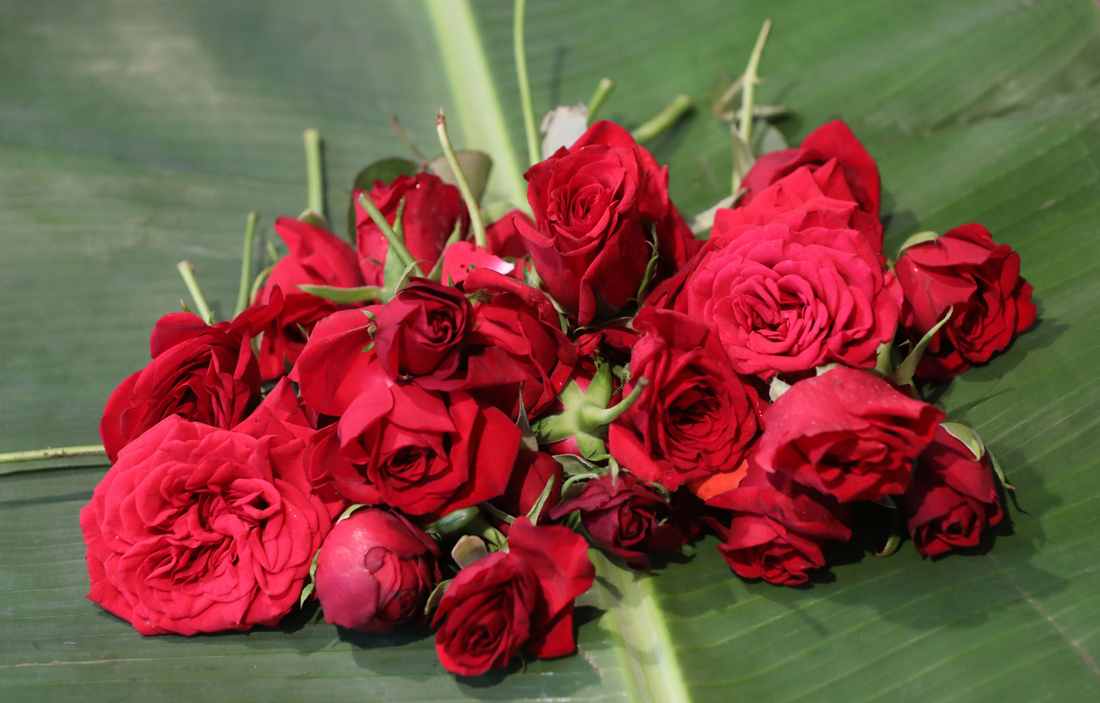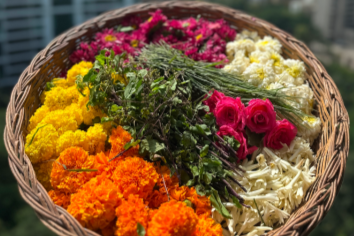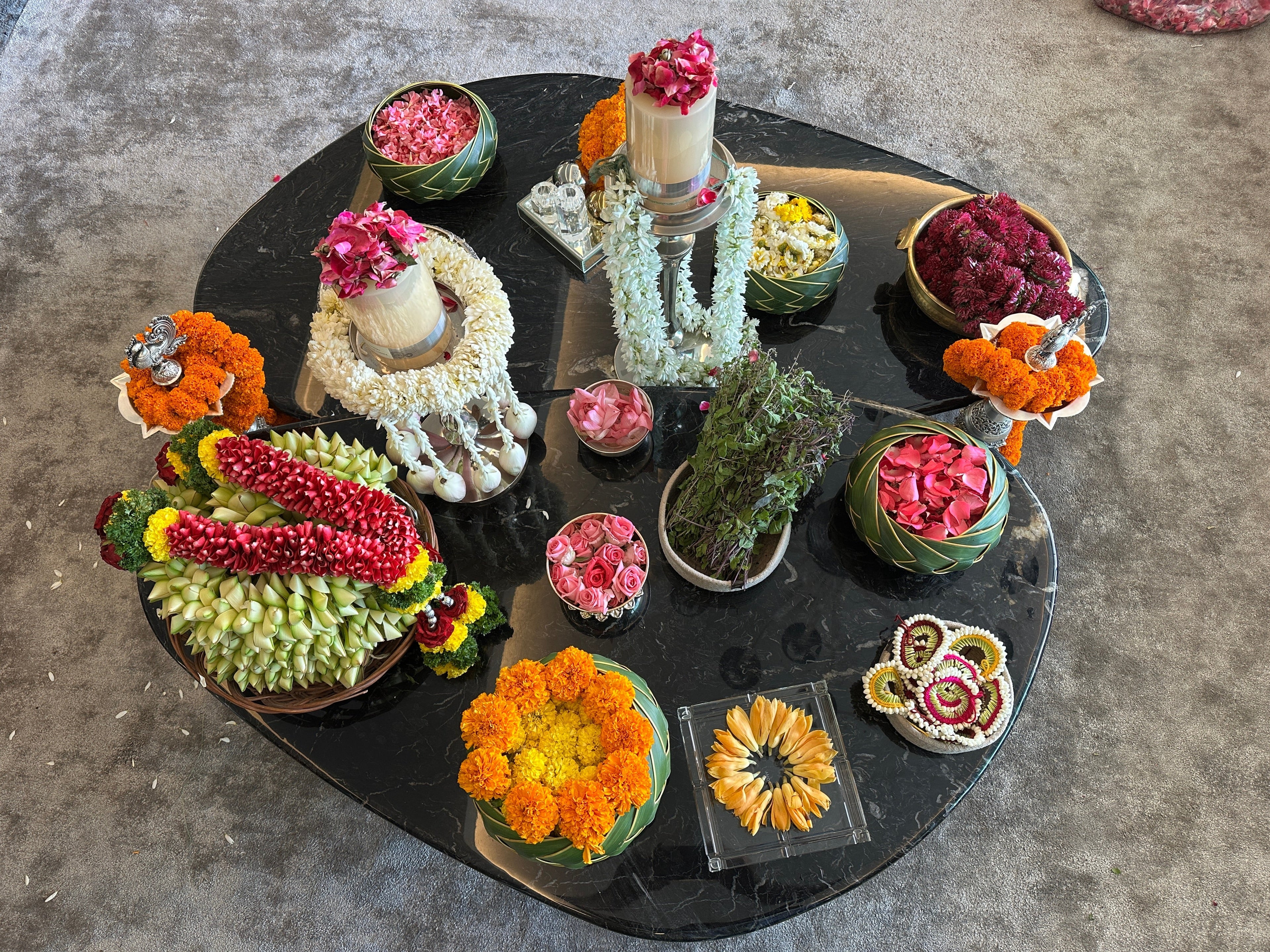
I've always placed fresh flowers at my home altar out of tradition, but last year during a particularly difficult period, I began noticing something unexpected. On days when I managed to get fresh flowers in Pune despite my hectic schedule, my meditation felt deeper, my mind clearer. Initially, I dismissed it as coincidence or confirmation bias. But when I began researching the science behind flowers, I discovered that my ancestors' insistence on fresh blooms wasn't merely ritual superstition—it was rooted in profound understanding of how flowers affect human consciousness.
Fresh flowers influence us on multiple levels—biochemical, psychological, energetic, and spiritual. This exploration uncovers the remarkable science behind these effects and how the presence of fresh blooms transforms not just our sacred spaces but our overall wellbeing in ways modern research is only beginning to validate.
Key Takeaways
-
Fresh flowers release phytoncides that purify air and enhance immune function when present in living spaces
-
Studies show exposure to fresh flowers significantly reduces stress hormones and increases positive emotions
-
The vibrational frequencies of specific flowers align with traditional chakra systems and energy centers
-
Certain flower fragrances demonstrably enhance meditation depth and alter brainwave patterns
-
Fresh flowers create measurable electromagnetic fields that interact with human bioelectricity
The Science of Flower Power
Phytoncides: Nature's Invisible Healers
The most scientifically validated benefit of fresh flowers comes through their release of phytoncides—antimicrobial volatile organic compounds that plants produce to protect themselves from harmful microorganisms. When we bring fresh flowers into our homes, these compounds:
-
Reduce airborne bacteria and fungal spores by up to 60% in enclosed spaces
-
Inhibit the growth of harmful microorganisms on surrounding surfaces
-
Create an atmosphere with measurably improved air quality
Research shows that peace lilies can remove 93.9% of benzene from indoor air within 24 hours, while chrysanthemums effectively filter formaldehyde and benzene from the environment. These purification properties explain why temple environments traditionally filled with fresh flowers often feel noticeably cleaner and more conducive to focused meditation.
Neurobiological Impacts on Human Wellbeing
The effects of flowers extend beyond air quality to directly influence our neurobiological state:
-
Stress Reduction: Studies show lavender reduces cortisol levels by 31% within 15 minutes of exposure
-
Memory Enhancement: Jasmine's linalool compound has been shown to increase hippocampal neuron growth by 25% in laboratory studies
-
Mood Elevation: Rose fragrance reduces anxiety and produces calming alpha brain waves in EEG measurements
-
Cognitive Performance: Research participants working in environments with fresh flowers demonstrated 15% higher scores on creative problem-solving tasks
These findings help explain why ancient traditions incorporated specific flowers into different spiritual practices—each bloom creates distinct neurobiological effects that support particular states of consciousness.
For more on the importance of freshness in flower selection, read our detailed guide on Pooja Flowers: Why Only Fresh Blooms Matter & What NOT to Offer.
Energy Medicine Perspectives
Vibrational Frequencies of Common Flowers
Beyond their biochemical properties, flowers emit measurable electromagnetic frequencies that interact with human energy fields. Research in biophysics has documented that:
-
Different flower species emit distinct frequency patterns
-
These patterns remain strongest within 6-8 hours of harvesting
-
Human proximity to fresh flowers creates measurable shifts in our own bioelectric fields
Fascinatingly, the frequencies of specific flowers align remarkably with traditional chakra systems:
-
Red roses: 320-350 Hz, corresponding to root chakra activation
-
Marigolds: 400-420 Hz, aligning with sacral chakra frequencies
-
Jasmine: 480-500 Hz, resonating with solar plexus energy
-
Lotus: 530-560 Hz, matching heart chakra vibrations
These correlations suggest our ancestors understood flower energetics with remarkable precision despite lacking modern measuring instruments.
Flower Meditation: Ancient Practice, Modern Validation
Flower meditation represents one of the oldest contemplative techniques for accessing altered states of consciousness. Modern research validates this approach:
-
Meditators focusing on lotus flowers show enhanced theta brainwave activity compared to non-flower meditation
-
The fractal patterns in flower petals naturally induce meditative states through visual entrainment
-
Floral fragrances activate the limbic system in ways that facilitate deeper meditative absorption
A simple practice involves:
-
Selecting a single, fresh flower
-
Observing its details with complete presence
-
Gradually expanding awareness to include the flower's subtle energy
-
Allowing the boundaries between observer and flower to dissolve
This technique creates measurably different meditation experiences compared to non-nature-based focal points, particularly enhancing feelings of connectedness and dissolving self-referential thought patterns.
To explore the complete journey of fresh flowers from farm to spiritual significance, see our comprehensive guide Fresh Flowers Decoded: The Complete Ecosystem from Farm to Spiritual Significance.
Ayurvedic Wisdom on Flower Therapy
Dosha-Balancing Properties of Common Blooms
Ayurveda recognizes specific healing properties in flowers commonly used in worship:
Jasmine (Mallika):
-
Balances Vata dosha through its warming, sweet properties
-
Reduces anxiety and nervous system agitation
-
Supports reproductive health and hormonal balance
-
Creates emotional stability during spiritual practice
Marigold (Genda):
-
Contains powerful anti-inflammatory compounds
-
Heals skin conditions (Pitta imbalances)
-
Supports liver function and detoxification
-
Strengthens the immune system
Lotus (Padma):
-
Provides cooling effects that balance excess Pitta
-
Strengthens heart energy and circulation
-
Creates mental clarity and emotional balance
-
Serves as a natural mild sedative without drowsiness
Rose (Gulab):
-
Acts as a heart tonic both physically and emotionally
-
Balances all three doshas but particularly Pitta
-
Rejuvenates skin and tissue health
-
Creates harmony between body and mind during spiritual practices
Hibiscus (Japa):
-
Cools Pitta with its refreshing properties
-
Supports healthy hair and skin
-
Benefits cardiovascular health
-
Grounds excessive mental energy
These properties explain why specific flowers are traditionally associated with particular deities—each bloom creates physiological and energetic conditions that facilitate connection with specific divine qualities.
Traditional Flower Remedies and Modern Adaptations
Ancient texts describe numerous flower-based remedies that modern research has begun to validate:
-
Rose Water: Traditional use for emotional balance now shown to reduce anxiety biomarkers
-
Jasmine Oil: Historical application for depression validated by studies showing serotonin-enhancing effects
-
Lotus Stem Extract: Ancient remedy for heart conditions confirmed to contain compounds that reduce blood pressure
-
Marigold Poultice: Traditional wound treatment verified to have powerful antimicrobial properties
These remedies represent the practical application of flower energetics beyond ceremonial contexts—bringing flower medicine into everyday wellness practices in ways that complement spiritual use.
For insights into sourcing genuinely fresh, ethically grown flowers, explore our article on The Cut Flower Industry's Dirty Secret & Why Local, Farm-Fresh Flowers Are the Future.
Practical Applications for Modern Life
Creating Sacred Space with Strategic Flower Placement
Beyond altar offerings, strategic flower placement throughout living spaces creates environments conducive to spiritual practice:
-
Entryway Flowers: Place purifying varieties like chrysanthemums near entrances to cleanse incoming energy
-
Meditation Space: Position heart-opening flowers like roses or lotus near meditation areas
-
Sleeping Areas: Locate calming blooms like jasmine or lavender in bedrooms to enhance rest
-
Work Spaces: Incorporate creativity-enhancing flowers like yellow marigolds near desks
-
Family Gathering Areas: Use community-supporting flowers like pink roses in shared spaces
This whole-home approach extends the benefits of flowers beyond formal ritual contexts into everyday living environments.
Flower Subscription: Consistent Access to Flower Benefits
For those seeking to maintain these benefits consistently, flower subscriptions provide a practical solution:
-
Regular deliveries ensure continuous access to fresh, beneficial blooms
-
Seasonal variety naturally aligns with changing energy patterns throughout the year
-
Time savings from eliminated market visits creates space for actual practice
-
Supporting ethical local growers ensures the flowers carry positive energy from their origins
Learn more about how subscriptions transform flower access in our analysis of Why Smart Buyers Are Choosing Flower Subscriptions.
Flower Care for Maximum Benefit
To maintain maximum energetic and biochemical benefits:
-
Morning Harvest/Purchase: Choose flowers collected during early morning when their life force is strongest
-
Proper Cutting: Cut stems at 45° angles under running water to maximize uptake
-
Water Quality: Use room-temperature water with a pinch of turmeric as a natural preservative
-
Energy Clearing: Pass new flowers briefly through incense smoke before placement
-
Regular Refreshing: Change water daily and recut stems every 2-3 days
These practices extend not just physical longevity but energetic potency—allowing you to receive maximum benefit from each bloom.
For comprehensive guidance on finding the freshest flowers in Pune, see our detailed resource Where to Find the Freshest Flowers in Pune: Complete Guide.0d01f2490219e4).
Cultural Wisdom Meets Modern Research
Global Perspectives on Flower Energy
The recognition of flowers' spiritual and healing properties spans cultures worldwide:
-
Traditional Chinese Medicine: Categorizes flowers by their energetic qualities (warming/cooling, rising/sinking)
-
Bach Flower Remedies: Identifies 38 flower essences addressing specific emotional states
-
Native American Traditions: Recognizes flowers as messengers between human and spirit worlds
-
Islamic Gardens: Designs spaces where flower fragrances enhance contemplation and prayer
These diverse traditions share core insights about flowers as mediators between physical and subtle realms—a perspective modern science is beginning to appreciate through research into how plant compounds influence consciousness.
The Frontier of Flower Research
Cutting-edge research continues to uncover new dimensions of flower effects:
-
Biofield Studies: Measuring the electromagnetic interactions between humans and fresh flowers
-
Consciousness Research: Exploring how flower essences influence subtle aspects of awareness
-
Chronobiology: Investigating how flower exposure affects circadian rhythms and sleep quality
-
Epigenetics: Examining how floral compounds influence gene expression related to stress response
These emerging fields suggest we're only beginning to understand the full spectrum of ways flowers influence human experience—with each discovery validating aspects of traditional wisdom.
FAQ: Common Questions About Flower Benefits
Can dried flowers provide the same benefits as fresh ones?
While dried flowers retain certain beneficial compounds, they lack many of the active properties that make fresh flowers so effective. Fresh flowers actively release oxygen, phytoncides, and aromatic compounds that dried versions cannot produce. Additionally, the electromagnetic field of a flower diminishes dramatically after harvesting, with dried flowers showing minimal measurable energy emissions. For spiritual and therapeutic applications, fresh flowers provide significantly greater benefits.
Which flowers are most effective for stress reduction?
Research consistently identifies several flowers with powerful stress-reducing properties:
-
Lavender: Reduces cortisol levels and promotes parasympathetic nervous system activation
-
Jasmine: Contains linalool, which demonstrably reduces anxiety markers
-
Rose: Particularly pink varieties, shown to reduce blood pressure and heart rate
-
Chamomile: Creates mild sedative effects without drowsiness
-
Lotus: Induces meditative brainwave states conducive to stress release
The effects are strongest when these flowers are truly fresh, ideally sourced within 24 hours of harvesting.
How do flowers affect sleep quality?
Certain flowers create measurable improvements in sleep architecture through their effects on the nervous system:
-
They reduce sympathetic (fight-or-flight) activation before bedtime
-
Their fragrances stimulate receptors that increase melatonin production
-
Their presence increases negative air ions associated with deeper sleep
-
Their beauty creates psychological relaxation that facilitates sleep onset
Jasmine, lavender, and gardenia show particularly strong effects on sleep improvement, with studies demonstrating 20-35% improvements in sleep quality measures when these fresh flowers are present in sleeping environments.
Is there scientific evidence for flowers affecting meditation?
Yes, multiple studies demonstrate measurable effects:
-
EEG measurements show increased alpha and theta waves during meditation with fresh flowers present
-
Attention focus duration increases by 18-23% in flower-enhanced meditation spaces
-
Subjective reports of meditation depth improve significantly with specific floral fragrances
-
Heart rate variability metrics (indicating relaxation) improve in the presence of fresh flowers
These findings validate traditional practices incorporating flowers into meditation environments and rituals.
Conclusion: Bridging Ancient Wisdom and Modern Life
The profound effects of fresh flowers on human consciousness aren't merely poetic metaphors or superstitious beliefs—they represent sophisticated understanding of how nature influences our physical, mental, and spiritual wellbeing. As science continues validating these traditional insights, we can approach flower selection with both reverence for ancient wisdom and appreciation for modern validation.
In our increasingly artificial environments, fresh flowers represent one of the most accessible ways to maintain connection with natural rhythms and life-supporting energies. Their presence transforms not just the visual aesthetic of our spaces but their fundamental energetic quality—creating environments more conducive to spiritual practice, emotional balance, and physical wellbeing.
Whether incorporated into formal altar arrangements, placed strategically throughout living spaces, or used in specific therapeutic applications, fresh flowers offer a remarkably simple yet powerful tool for enhancing quality of life. Their ephemeral nature—blooming, radiating beauty and fragrance, then returning to the earth—itself embodies spiritual lessons about impermanence, beauty, and the preciousness of each moment.
By bringing fresh flowers into your daily environment with conscious intention, you invite their multidimensional benefits while participating in a practice that connects you with countless generations of wisdom keepers who recognized these remarkable beings as bridges between visible and invisible worlds.

